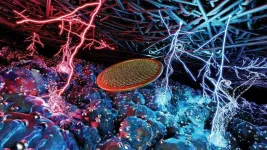(Press-News.org) UNIVERSITY PARK, Pa. — Early life exposure to ‘forever chemicals’ in the environment permanently disrupts the gut microbiome in mice, contributing to the development of metabolic disease in later life, according to new research led by Penn State. The results, published today (Aug. 14) in the journal Environmental Health Perspectives, suggest that human exposure to these chemicals during early childhood may be contributing to the recent epidemic of metabolic disorders, including obesity and type 2 diabetes among adults.
The researchers focused specifically on 2,3,7,8-tetrachlorodibenzofuran (TCDF), a widespread persistent organic pollutant (POP) that is a byproduct of waste incineration, metal production, and fossil-fuel and wood combustion. TCDF accumulates in the food chain, and humans are primarily exposed through consumption of high-fat foods, such as meat, dairy products and some fish. Babies can be exposed through consumption of breast milk.
“POPs are pervasive in the environment and nearly every living organism has been exposed,” said Andrew Patterson, John T. and Paige S. Smith Professor of Molecular Toxicology and of Biochemistry and Molecular Biology, Penn State. “The negative health effects of these chemicals are well documented and include birth defects and cancer. Our study is the first to suggest that early-life exposure to a certain POP, called TCDF, also disrupts the gut microbiome and is associated with metabolic disorders later in life.”
The team examined the effects of TCDF in two groups of mice — a test group, or those treated with TCDF and a control group, or those receiving no treatment. The team fed four-week-old mice from pills containing either 0.46 micrograms (µg) of TCDF or a control pill that did not contain any TCDF for five days. While 0.46 µg is higher than what is typically found in the diets of humans, it is not high enough to cause toxic illness.
“In our study we used a dose that is relatively high compared to typical human exposures; however, we can use this information to identify new toxicity high points, including in the gut microbiome, and begin to extrapolate what might happen at even lower doses. Of course, we also must consider how complex mixtures of these POPs interact with us and our microbial partners because a single exposure does not perfectly mimic real life scenarios.”
Next, the researchers examined the animals’ gut microbiomes, along with several indicators of the animals’ health, including body weight, glucose tolerance, and the amounts of triglycerides in their livers and mucus in their feces, among other markers of metabolic disease. They collected these data immediately following the five-day course of TCDF, as well as three months after the last dose. In humans, these time points are equivalent to an infant and a young adult.
“We found that early life exposure to TCDF permanently disrupted the gut microbiomes of the wild-type mice,” said Yuan Tian, lead author and associate research professor, Penn State. “We also found that these mice had higher body weight and glucose intolerance at age four months.”
To further explore the effects of TCDF on the gut microbiome, the scientists gave mice without microbiomes intestinal microbiome transplants from the mice with TCDF-disrupted microbiomes and measured their health outcomes. They found that the mice with the transplants developed metabolic disorders, indicating that the altered microbiome is the cause of the metabolic disease.
“These results suggest that early-life TCDF exposure may be causing the disturbances in gut microbiome function and health outcomes later in life, even well after the TCDF has been eliminated from the body,” Tian said.
She explained that the gut microbiome disturbances were marked by a decrease in certain bacterial species, including Akkermansia muciniphila, a bacterium that is also typically found in the human gut microbiome.
“This is important because Akkermansia is recognized as important for overall gut health, but now we know that it can be adversely affected by TCDF,” Tian said.
To investigate the importance of Akkermansia muciniphila in influencing health outcomes, the team experimented with administering the bacterium as a probiotic to TCDF-treated mice. The probiotic restored the microbiome to its normal state.
“Our findings suggest that these bacteria are influenced by toxic exposure and play an important role in mediating health outcomes,” Patterson said. “It may be possible that with more research we could one day restore a person’s microbiome to its optimal state through supplementation with pre- and probiotics.”
Other Penn State authors on the paper include Jordan Bisanz, assistant professor of biochemistry and molecular biology; Imhoi Koo, assistant research professor; Iain Murray, assistant research professor; Shigetoshi Yokoyama, assistant research professor; Sergei Koshkin, assistant research professor; Bipin Rimal, graduate student; Wei Gui, research technologist; Shaneice Nettleford, graduate student; Fangcong Dong, postdoctoral fellow; Sandeep Prabhu, head, Department of Veterinary and Biomedical Sciences; and Gary Perdew, H. Thomas and Dorothy Willits Hallowell Chair in Agricultural Sciences. Other authors include Trenton Wolfe, graduate student, Montana State University; Peter Turnbaugh, professor of microbiology and immunology, University of California, San Francisco; and Seth Walk, professor of microbiology and immunology, Montana State University.
The U.S. National Institutes of Health, U.S. National Institute of Food and Agriculture and Pennsylvania Department of Health supported this research.
END
Early life exposure to common chemical permanently disrupts gut microbiome
A study in mice finds that by significantly disrupting the gut microbiome, early life exposure to persistent organic pollutants influenced the development of metabolic disorder in adult mice
2024-08-14
ELSE PRESS RELEASES FROM THIS DATE:
Rocks collected on Mars hold key to water and perhaps life on the planet. Bring them back to Earth.
2024-08-14
Over the course of nearly five months in 2022, NASA's Perseverance rover collected rock samples from Mars that could rewrite the history of water on the Red Planet and even contain evidence for past life on Mars.
But the information they contain can't be extracted without more detailed analysis on Earth, which requires a new mission to the planet to retrieve the samples and bring them back. Scientists hope to have the samples on Earth by 2033, though NASA's sample return mission may be delayed.
"These samples are the reason why our mission was flown," said paper ...
Nighttime light data shows inequities in restoring power after Hurricane Michael
2024-08-14
Among the many devasting impacts in the aftermath of a hurricane are power outages, which can take days or even weeks to restore. Communities grappling with the loss of electricity may encounter obstacles in accessing vital services, including food, fuel and health care.
In 2018, Hurricane Michael, a Category 5 storm, wreaked havoc in Florida as it made landfall in the United States. It was strongest recorded to hit the Florida Panhandle with winds of nearly 161 miles per hour and storm surge reaching heights ...
Rising mercury pollution in soil could be related to climate change, study says
2024-08-14
In 2017, the Minamata Convention on Mercury went into effect, designed to help curb mercury emissions and limit exposure across the globe. However, a new study of mercury levels in soil suggests that the treaty’s provisions might not be enough. The study published in ACS’ Environmental Science & Technology estimates that soil stores substantially more mercury than previously thought, and it predicts that increases in plant growth due to climate change may add even more.
Mercury is a persistent environmental pollutant, moving through air, water and soil, and accumulating within plants ...
Exploring the structures of xenon-containing crystallites
2024-08-14
Noble gases have a reputation for being unreactive, inert elements, but more than 60 years ago Neil Bartlett demonstrated the first way to bond xenon. He created XePtF6, an orange-yellow solid. Because it’s difficult to grow sufficiently large crystals that contain noble gases, some of their structures — and therefore functions — remain elusive. Now, researchers have successfully examined tiny crystallites of noble gas compounds. They report structures of multiple xenon compounds in ACS Central ...
Oral cancer screening: Insights into epidemiology, risk factors, and screening programs for improved early detection
2024-08-14
Cancer is a complex disease characterized by uncontrolled cell growth, significantly impacting global health. Head and neck cancers rank as the sixth most prevalent cancers worldwide, with a higher incidence in South-central Asia. Oral squamous cell carcinoma (OSCC) is the predominant malignancy in this category, posing a significant health concern due to its high mortality and often late-stage diagnosis. The significance of early detection and appropriate screening measures cannot be overstated, as they play a pivotal role in improving survival rates and reducing the disease burden.
Overview ...
AAAS and Chen Institute inaugurate new prize recognizing innovative applications of AI techniques
2024-08-14
In collaboration with the Tianqiao and Chrissy Chen Institute, the American Association for the Advancement of Science (AAAS) is announcing the establishment of the Chen Institute and Science Prize for Al Accelerated Research. Submissions are now open for the first year of the prize, which will be awarded in 2025.
The prize will recognize young researchers who apply techniques in artificial intelligence (AI) – such as machine learning, natural language processing, or computer vision – to help the life sciences research community solve important problems and accelerate their work. Successful applicants will have made a fundamental advance that would not have been ...
A method that paves the way for improved fuel cell vehicles
2024-08-14
More efficient and longer-lasting fuel cells are essential for fuel cell-powered heavy-duty hydrogen vehicles to be an alternative to combustion fuelled counterparts. Researchers at Chalmers University of Technology, Sweden, have developed an innovative method to study and understand how parts of fuel cells degrade over time. This is an important step towards the improved performance of fuel cells and them becoming commercially successful.
Hydrogen is a fuel alternative that is becoming increasingly interesting for heavy-duty vehicles. Hydrogen-powered vehicles only emit water vapour as exhaust, and if the hydrogen is produced using renewable energy, it is completely free ...
How air-powered computers can prevent blood clots
2024-08-14
A new, air-powered computer sets off alarms when certain medical devices fail. The invention is a more reliable and lower-cost way to help prevent blood clots and strokes — all without electronic sensors.
Described in a paper in the journal Device, the computer not only runs on air, but also uses air to issue warnings. It immediately blows a whistle when it detects a problem with the lifesaving compression machine it is designed to monitor.
Intermittent pneumatic compression or IPC devices are leg sleeves that fill with air periodically and ...
Fear of appearing prejudiced can inhibit accurate performance feedback to women
2024-08-14
PULLMAN, Wash. – Evaluators who want to avoid appearing prejudiced may overcorrect and give women inflated performance feedback, new research indicates, which is a practice that could ultimately hinder their ability to improve and advance.
A Washington State University-led research team investigated the connection between overly positive performance reviews and “protective paternalism,” the belief that women need to be handled carefully and shielded from harm.
While it may be well-intentioned, ...
Chromatin structure plays a key role in canine social behavior evolution
2024-08-14
A new study on dogs found that chromatin's spatial structure has a significant role in the evolution of social behavior. Chromatin, the compact form of DNA, not only packages genetic material but also plays a crucial role in gene regulation. This study demonstrates that both the linear sequence of DNA and its three-dimensional configuration are linked to friendly behavior shaped by dog domestication, providing new insights into the molecular mechanisms underlying social traits.
Behavioral traits such as sociability are influenced by numerous genes, their interactions, environmental factors, and individual life experiences.
Because ...
LAST 30 PRESS RELEASES:
Exposure to natural light improves metabolic health
As we age, immune cells protect the spinal cord
New expert guidance urges caution before surgery for patients with treatment-resistant constipation
Solar hydrogen can now be produced efficiently without the scarce metal platinum
Sleeping in on weekends may help boost teens’ mental health
Study: Teens use cellphones for an hour a day at school
After more than two years of war, Palestinian children are hungry, denied education and “like the living dead”
The untold story of life with Prader-Willi syndrome - according to the siblings who live it
How the parasite that ‘gave up sex’ found more hosts – and why its victory won’t last
When is it time to jump? The boiling frog problem of AI use in physics education
Twitter data reveals partisan divide in understanding why pollen season's getting worse
AI is quick but risky for updating old software
Revolutionizing biosecurity: new multi-omics framework to transform invasive species management
From ancient herb to modern medicine: new review unveils the multi-targeted healing potential of Borago officinalis
Building a global scientific community: Biological Diversity Journal announces dual recruitment of Editorial Board and Youth Editorial Board members
Microbes that break down antibiotics help protect ecosystems under drug pollution
Smart biochar that remembers pollutants offers a new way to clean water and recycle biomass
Rice genes matter more than domestication in shaping plant microbiomes
Ticking time bomb: Some farmers report as many as 70 tick encounters over a 6-month period
Turning garden and crop waste into plastics
Scientists discover ‘platypus galaxies’ in the early universe
Seeing thyroid cancer in a new light: when AI meets label-free imaging in the operating room
Neutrophil-to-lymphocyte ratio may aid risk stratification in depressive disorder
2026 Seismological Society of America Annual Meeting
AI-powered ECG analysis offers promising path for early detection of chronic obstructive pulmonary disease, says Mount Sinai researchers
GIMM uncovers flaws in lab-grown heart cells and paves the way for improved treatments
Cracking the evolutionary code of sleep
Medications could help the aging brain cope with surgery, memory impairment
Back pain linked to worse sleep years later in men over 65, according to study
CDC urges ‘shared decision-making’ on some childhood vaccines; many unclear about what that means
[Press-News.org] Early life exposure to common chemical permanently disrupts gut microbiomeA study in mice finds that by significantly disrupting the gut microbiome, early life exposure to persistent organic pollutants influenced the development of metabolic disorder in adult mice





